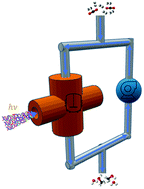Continuous reactor for renewable methanol†
Abstract
For society and corporations to decisively shift to fossil fuel alternatives and avoid the likely devastating consequences of climate change and ecosystem destruction of ‘business-as-usual’, a renewable pathway to carbon net-neutral or net-negative feedstocks is of utmost importance. Methanol (MeOH) is a promising candidate but is still produced with conventional natural gas to syngas technology. The need for fossil-free and less costly syngas routes to MeOH has been the focus of immense academic effort. Towards this end, this study details a version 1.0 tool for investigating prospective photochemical and thermal heterogeneous MeOH synthesis catalysts and present thermal benchmarking data with a commercial copper–zinc oxide-alumina (CZA) catalyst. The testing conditions use a 3 : 1 H2 : CO2 syngas ratio, temperatures from <448–533 K (<175–260 °C), and pressure up to 0.78 MPa. These conditions allow for more efficient CO2 utilization by improving low-temperature MeOH yield and reducing capital and operating costs of process equipment. The reactor performance is validated with respect to the literature and also a rate model based on a Langmuir–Hinshelwood–Hougen–Watson (LHHW) mechanism with good agreement. This verifies that the system behaves isothermally and predictably. This unique system can be configured to screen catalysts both thermally and with light, and expanded to commercial test conditions and scales. At aspirational low-temperature and low-pressure conditions, 398 K (125 °C) and 1.0 MPa (comparable P to this study), the MeOH equilibrium per-pass yield is a respectable 8.8 mol% with comparable high-P equipment costs to current commercial operations.



 Please wait while we load your content...
Please wait while we load your content...